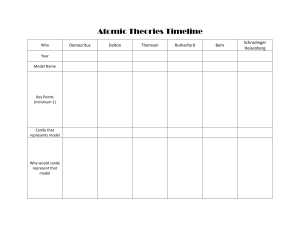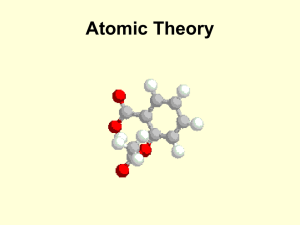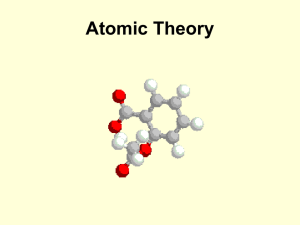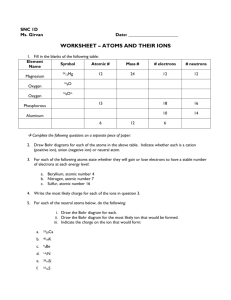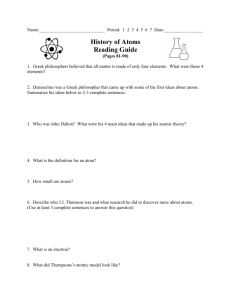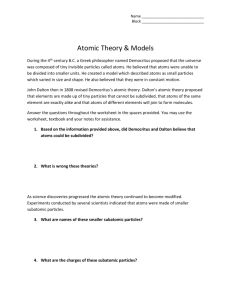Atomic Theories Timeline
advertisement
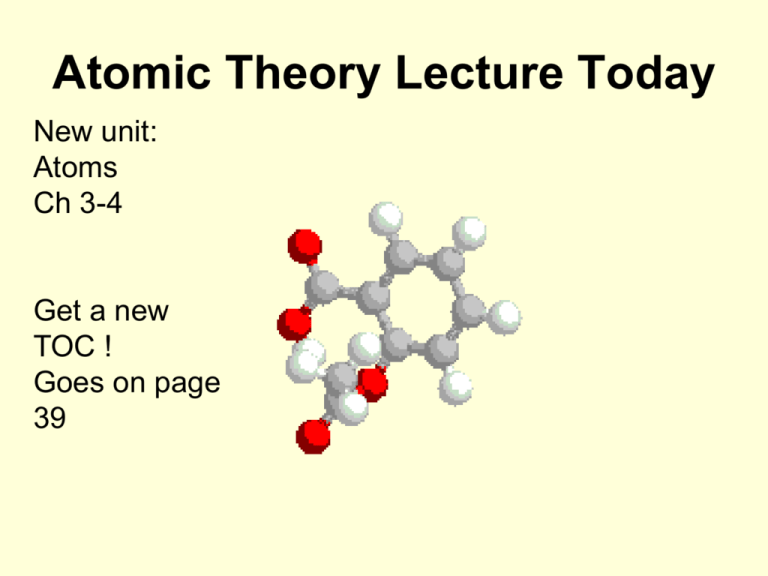
Atomic Theory Lecture Today New unit: Atoms Ch 3-4 Get a new TOC ! Goes on page 39 Let’s Take a Trip Through Time! Notes on page 45 1964 Quarks-Cal Tech 1932 • James Chadwick • 1891-1974 discovers the neutron Ernst Schrödinger 1887-1961 Werner Heisenberg 1901-1976 • Quantum Mechanical Model 1926 – Electrons are in probability zones called “orbitals”, not orbits and the location cannot be pinpointed – Electrons are particles and waves at the same time – Developed quantum numbers based on theories of Einstein and Planck – 1930 Schrodinger developed mathematical model Orbitals Quantum Mechanical Theory Electron in a Hydrogen atom Pick A Candy! Niels Bohr 1885-1962 • Planetary Model 1913 – Nucleus surrounded by orbiting electrons at different energy levels – Electrons have definite orbits • Utilized Planck’s Quantum Energy theory • Worked on the Manhattan Project (US atomic bomb) Bohr’s Model Bohr Model for Nitrogen Pick A Candy! Ernest Rutherford 1871-1937 • Nucleus Theory 1910 – alpha particle gold foil experiment • An atom’s mass is mostly in the nucleus • The nucleus has a positive charge (Moseley) • Electrons in fixed orbit Alpha Particle Experiment Aka: Gold Foil Experiment Rutherford Model Pick a Candy! J.J. Thomson 1856-1940 • Discovered electron 1897 – Cathode Ray Experiment • Plum Pudding model 1904 – Electrons in a soup of positive charges • Discovered isotopes 1913 JJ Thompson’s Ideas Cathode Ray Tube Experiment Plum Pudding Model Pick a Candy! John Dalton 1766-1844 • Introduced his ideas in 1803 • Each element is composed of extremely small particles called atoms • All the atoms of a given element are identical, but they differ from those of any other element • Atoms are neither created nor destroyed in any chemical reaction • A given compound always has the same relative numbers and kinds of atoms Dalton’s Model Pick a Candy ! Democritus 460 – 370 B.C. • There are various basic elements from which all matter is made • Everything is composed of small atoms moving in a void • Some atoms are round, pointy, oily, have hooks, etc. to account for their properties • Ideas rejected by leading philosophers because void = no existence First Concept of an Atom Pick a Candy ! Atomic Theory JJ Thomson Democratus Niels Bohr Chadwick 400 BC 1803 John Dalton 1904 1910 Ernest Rutherford 1913 1926 1932 Schroedinger / Heisenberg CaltechQuarks 1964 Next Atomic Theory Which one of you will develop a better theory and win the Nobel Prize? Pick Your Favorite Candy and Enjoy! P.44 Atomic Theories Timeline Name Time Frame Key Points Candy Model Democritus Dalton Thomson Rutherford Bohr Schrödinger Heisenberg
